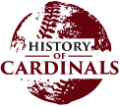Cardinals History for February 22nd
1938– After college, Texas Christian football All-American Sammy Baugh signs a contract with the Cardinals. ‘Slingin’ Sammy’, who will experience little playing time as a backup to starting shortstop Marty Marion, will leave the minor leagues to become the quarterback for the Washington Redskins of the National Football League.
1993– The St. Louis Cardinals traded Felix Jose and Craig Wilson to the Kansas City Royals for Ed Gerald (minors) and Gregg Jefferies.
Birthdays
Charlie Moran played for the Cardinals in 1903 but had a varied sports career. Born on February 22, 1878
Jumbo McGinnis -1874
Roy Radebaugh Born on February 22, 1881
Clarence Mitchell (February 22, 1891 – He was the last legal left-handed spitball pitcher.
Tony DeFate (February 22, 1895
Joe Gannon- 1877
-Patsy Tebeau 1868
Bill Baker (February 22, 1911–
Rick Heiserman (born February 22, 1973 i
Former Cardinals That Died on this Date
Owen “Chief” Wilson- 1954 —- in 1912 he had 36 triples in one season
Sammy Samuels -1964
Andy High- 1981
